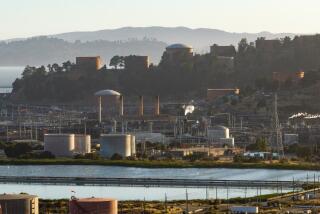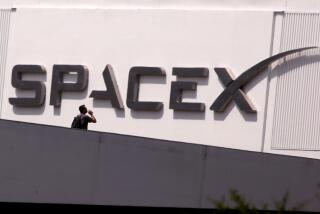Prickly Relocation Issue at Hughes : Talk of Moving Missile Unit to Arizona Chills Workers
- Share via
Some engineers and scientists at Hughes Aircraft are sporting lapel buttons that show a cactus overlaid by a circle and slash--symbolic language for “no cactus.”
They are objecting to the possible relocation of Hughes Missile Systems Group from a research campus in Canoga Park to a company missile factory in the Arizona desert, just outside of Tucson.
Hughes is considering a transfer of 3,251 Hughes’ employees, 43% of whom are design engineers and scientists with graduate degrees. As a center of aerospace technology, Hughes’ Canoga Park facility is regarded as among the best in the industry and is credited with a series of important tactical missile developments over the last 30 years.
Despite its past success, though, Hughes says it needs to improve the efficiency of its $1.3-billion missile business, which is facing unprecedented competition that has challenged the firm’s longstanding claim that it is the nation’s largest producer of tactical missiles.
A victim of the Pentagon’s widely heralded competition initiatives, Hughes has watched other companies, most notably Raytheon, win contracts to produce missiles that Hughes has designed. While the Hughes missile operation is healthy and profitable now, market conditions are growing more adverse.
“The competition is getting stiffer,” said Theodore W. J. Wong, president of Hughes missile group. “Our business situation is really pretty good right now. What I am concerned about is being able to sustain or to increase the size of our operation in the out years--two or three years from now.”
The cost of the move would certainly not be trivial and some experts estimate that it could easily reach into the tens of millions--if not hundreds of millions--of dollars.
An internal study on the relocation is expected to yield a decision within the next month, but many irate engineers say the decision has already been made to abandon the sprawling Canoga Park facility, located on 86 acres at the foot of the Santa Susana Mountains.
“The people here feel it is a foregone conclusion that the move will be made,” said one veteran Hughes missile engineer. “The way I look at it is that they have already made up their mind to go, unless they find a good reason not to go.”
Indeed, Hughes has imposed a freeze on all job transfers from the missile systems group to other Hughes operations, which many engineers believe is evidence that a decision has already been reached.
But a company statement issued to The Times said the freeze is “necessary to ensure the stability of the work force” and termed it a “common industry practice” when such a move is under consideration.
Nonetheless, emotions are running especially high among long-time Hughes’ engineers who have homes and families in the area. Moreover, Los Angeles has a fertile technical community in terms of the engineering schools located here and the professional associations that meet monthly throughout the region.
“Technical talent is excellent,” Wong acknowledged about Los Angeles. “But it is very very competitive. You get into bidding wars (for employees). Our young people . . . sometimes struggle with the cost of getting into a house.”
Wong said the primary reason for studying the move is not related to business conditions in Los Angeles. Rather, the firm wants to consolidate all of its missile operations at one site.
“At some stage we have to do what is right for the whole organization because that is the well being of the majority of our people,” Wong said.
At present, Hughes missile systems group has its executive offices and its advanced design staff in Canoga Park. But production engineering and missile production is done in Tucson at a plant owned by the Air Force and operated by Hughes.
The separation between Canoga Park and Tucson dates back to the early 1950s, when the Air Force felt that locating production plants near the Pacific Coast made them more vulnerable to enemy attack.
But the years of separation have resulted in communications lapses and cultural clashes between the two facilities, something that became known within Hughes as the “Cactus Curtain.” Hughes has attacked the cactus curtain in recent years, but the physical separation has proven to be a more difficult problem to fix.
“Cactus Curtain is a mentality,” Wong said. “I believe Cactus Curtain was an appropriate term a few years ago. I really believe that there may be some prickles left but they aren’t cactus. But there still is a great deal of inconvenience. You can’t ignore that, when it takes hours to get down there (Tucson), and you can’t talk with people on a daily basis, it just doesn’t open up avenues for design decisions.”
Hughes’ officials have come under a great deal of political pressure since it became known that the company was studying a pullout from Canoga Park.
Rep. Elton Gallegly (R-Simi Valley), whose district includes the Hughes’ facility, said he has sought to turn the tables on Arizona by persuading Hughes’ officials to transfer their Tucson plant to Canoga Park.
Gallegly said Hughes’ officials recognize that Tucson “is an area, for the most part, not nearly as desirable as this part of California.”
But Rep. Jim Kolbe (R-Ariz.), whose district includes the Hughes missile factory in Tucson, was quoted by the Arizona Daily Star as saying: “Southern California employers are looking outside California because of deterioration in the quality of life there.”
Tucson has taken some hard knocks from the Hughes’ plant.
It now employs 7,400, down sharply from the peak of 9,000 it reached in 1985. In addition, the company disclosed only last month that another 600 salaried jobs there would be cut.
Wong said Hughes Chairman Albert Wheelon will make the final decision for the company after he receives the recommendations from the internal study and from an outside consultant that Hughes has hired.
One other important factor is the position the Pentagon takes. Any sort of large-scale transfer would be likely to affect the various Air Force, Navy and Army contracts that Hughes holds.
The move would probably affect the cost basis of those contracts, which could open them to renegotiation. In that event, the Pentagon’s position on those contracts would be likely to affect in a major way the economic feasibility of the move.
In the meantime, employees are watching every move of management closely to predict the outcome of the study.
When Wong recently ordered a Chevrolet Blazer, an off-road type vehicle, some apparently assumed it meant he was preparing for life in Tucson.
“I told them, it is the absolute truth, that car is one that my son has been coveting for years and I promised him I would get him one,” the affable Wong said. “So, when I get through with it, he is going to inherit it.”
More to Read
Sign up for Essential California
The most important California stories and recommendations in your inbox every morning.
You may occasionally receive promotional content from the Los Angeles Times.











